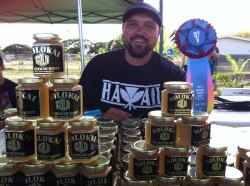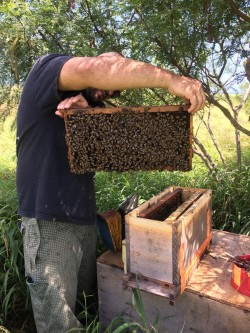Molokai Gold a Buzzing Business
The lure of creamy, golden honey from a local business is giving people across the islands bees on the brain. If you haven’t heard the buzz, Molokai is home to the best honey in Hawaii—that’s according to judges at the 2013 Hawaiian Natural Honey Challenge.
Molokai Gold, a year-old honey company run by beekeepers Micah Buchanan and Marshall Joy, is whipping up raw, unfiltered and natural honey.
“It was my honor and privilege to receive your beautiful honeys and prepare them for the Formal Judging and Public Tasting,” registrar of the Honey Challenge Pattie Rechtman said of Molokai Gold in a letter to Joy. “I was also able to taste most of the honeys, and I share the opinion held by those who first conceived of this Challenge four years ago, that your honeys are the best in the world.”
Their claim to fame is thanks to nectar from a tree found across the island— the kiawe. It’s what makes Molokai Gold honey so special, Buchanan said.
“Our honey is special because of the kiawe flower that the honey is coming from,” Buchanan said. “One tree is like a field of flowers. You need kiawe to get great honey. That’s the key.”
It’s the Bee’s Knees
The kiawe tree is what gives the honey its light gold color and sweet, signature taste, which keeps diehard customers coming back for more.
“The honey is super good and pure,” said Patricia Hammond of Molokai Soaps.
Molokai Gold only sells honey on Molokai due to high demand. Jars can be bought at Saturday Market or other events or ordered by phone. The prices range from $12 to $13 a small jar and $20 a large jar. Often, Molokai Gold sells out within weeks of harvesting a new batch.
“I wish there was a way he could make more honey quicker,” said community member Nani Kahinu. “As soon as I see his Instagram posts I buy it before it’s gone.”
Kahinu has honey delivered to her home and uses it as a remedy for colds, headaches and stomachaches.
“My family buys Molokai Gold because it’s our number one go-to for any illness we may have,” Kahinu said. “You’d be surprised what honey does for the body. It’s a perfect at home remedy and it’s made on Molokai.”
Kahinu said she loves the taste, as well as its medicinal properties.
“We love the kiawe raw honey and its pure flavor,” Kahinu said. “We hardly use it for eating, but use it for our get-well cough syrup. Anytime we’re felling the sniffles, Molokai Gold is our go-to, hands-down.”
Hammond said the number one reason she likes Molokai Gold Honey is because it comes from Molokai.
“The best honey comes from the source, from somebody I know and somebody that’s from here,” Hammond said. “I like the fact that [Buchanan is] Molokai born and raised and I use his honey in my soaps and other products.”
Rave Reviews
Conducted by the Big Island Beekeepers Association, the Honey Challenge last December received 132 entries from 41 beekeepers around the state. Contestants showcased their honey to be scored on color value, moisture content, appearance, aroma, texture and taste, said Rechtman.
Molokai Gold won three first-place Blue Rosette Ribbons and platinum sticker awards at the competition.
The team scored best solid honey with a total score of 42.75 out of 50 points. According to Buchanan, while most honey is more liquid form Molokai Gold is thicker in texture. The comments from the judges boasted of the honey being “Amazing, light, fruity,” having a “nice light color,” and that it “melts in the mouth.”
When it came to the honeycomb, the duo scored Best Comb Honey thanks to remarks from the judges and Rechtman stating, “YUMMY, crunchy butterscotch flavor, we LOVED THIS at my house!!!” The team won Best Solid Honey Tropical Multifloral for it’s noted “mango color, kiawe taste, fragrant smell.”
Making Gold
Molokai Gold’s apiary, or collection of beehives, is located on 40 acres of homestead land in Pala`au with countless fields of kiawe. The land is Buchanan’s grandfather’s, who was in the trade of growing watermelons.
In the past, Buchanan farmed strawberries, onions, lettuce and water crest, but is now dedicated to his 30 hives with hundreds of honeybees in each that he checks daily.
Neither Joy nor Buchanan were experts before they began beekeeping. Buchanan had bees on his farm and decided to pursue beekeeping to help pollinate his crops. He took to YouTube to spark his interest. After getting serious, he looked to local kupuna and farmers for guidance on beekeeping and trained with advanced beekeepers on Molokai.
Joy, who farmed and did casual beekeeping in the past, was the first person Buchanan turned to for advice on beekeeping. In July 2013, the duo teamed up to start a dozen starter hives on Buchanan’s farm and kickoff their business, Buchanan said.
Each hive box is filled with frames that bees build honeycombs onto to produce honey. The frames have a variety of functions – the middle frames are for larvae and the outer frames stores honeycombs of pollen and honey. Larger boxes, called honey boxes, are placed on top of the small box of frames for the bees to migrate into and solely produce honey. The frames are typically harvested in the summer, when they are the most filled with honey, Buchanan said.
It can take a year for the bees to produce honey that’s ready to be extracted. When a frame is completely filled with honey, the cells of the honeycomb will be capped by the bees for storage—or sealed with a white cap made of beeswax, which must be scrapped off. To extract the honey, Joy and Buchanan first remove the capped portion from the honeycomb with a plastic scraper, so it’s isolated in a liquid form.
Once the honey is ready to be harvested, it is poured into a spinner that Buchanan or Joy crank by hand to churn the honey. Next, the honey is lightly filtered to remove any debris. Then, the honey is left to sit in a bucket for a couple of days and churned once daily. Lastly, it’s bottled and ready for sale.
Although the wait for honey is long, the reward is worthwhile.
“A lot of beekeepers fall through because of the wait to get the pay back, but for us it’s well worth it,” Buchanan said.
To order Molokai Gold honey or request bee, or beehive, removals call Micah at 349-0818. Follow Molokai Gold on Instagram @fama_man to keep up with their buzzing business.















it is happiness to get good news..honey is so good for you. I pray God’s blessing on your business. we need it here!
Amen! Considering the big time concerns on the continent America, the bees population is diminishing. GMOs don’t need bees. Be watchful!